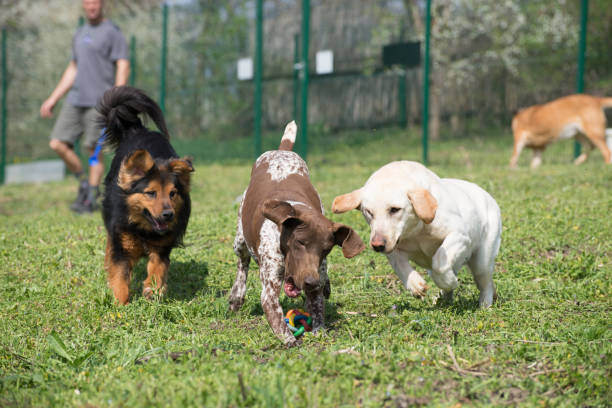In the U.S., more than 72% of dogs exhibit some kind of problematic behavior, whether that’s anxiety, sensitivity to stimuli, or aggression. This raises concern for pet businesses like yours. How can you keep staff and dogs safe and happy when behavioral issues are so common?
Temperament tests enable you to identify which pets should be accepted into your facilities while reducing the risk of accepting pets that could expose themselves, other dogs, and your staff to injury. To help you navigate this process, we’ll cover:
- Dog Temperament Test Basics
- How to Conduct a Dog Temperament Test
- Managing Dog Temperament Test Outcomes
Before diving into tactical tips, let’s brush up on the basics you need to understand how and why temperament tests are done.
Dog Temperament Test Basics
What is temperament?
Some define temperament simply as a dog's personality.
Dr. Radcliffe Robins’ research on dog temperament cites a few experts: Norma Bennett Woolf, author of Dog Owner’s Guide, describes temperament as “the general attitude a dog has towards other animals and people.” Wayne Davis of the West Virginia K9 College offers this more thorough definition: “The physical and mental characteristics of an individual dog, made evident through its reaction to stimuli in its environment.”
What are temperament tests for dogs?
A temperament test evaluates a dog's physical and mental characteristics and its reaction to other dogs' behaviors. This promotes safety and success in a group setting, like a dog daycare.
The purpose of the test is to look for aggressive behavior toward people and other dogs. Additionally, the test can help you ascertain general personality characteristics, such as separation anxiety, timidness, toy aggression, leash aggression, and other behaviors that could present risks to the pet or other guests.
Are dog temperament tests accurate?
Think of temperament testing as a tool that can help you establish a baseline understanding of a new dog’s temperament. While there is no perfectly accurate method for testing a dog’s temperament, it's better to be safe than sorry when it comes to identifying aggressive behaviors. You can always adjust how you manage individual dogs as your staff becomes more familiar with them.
There are ways to boost the reliability of your test results, however. If possible, avoid testing very young puppies, as results tend to be more accurate for older dogs. Control as many variables as you can for each test, such as location, noise levels, and the people and dogs present for the test, to avoid distractions that could alter the outcomes. Finally, either work with a dog behaviorist or obtain the necessary education and credentials to carry out these tests yourself.
What are the benefits of dog temperament testing?
Dog temperament testing may feel like an unnecessary hurdle just to onboard new clients. However, it’s well worth the extra time and effort for these benefits:
- Improved safety for both dogs and staff
- Better experiences for pets, particularly dogs that are shy or anxious
- Enhanced group dynamics, made possible by grouping dogs with similar energy levels and compatible temperaments together
- Improved customer satisfaction and retention, won by prioritizing safety and creating customized experiences for their furry friends
You can also use the fact that your business conducts testing as a unique selling point in your marketing efforts. Highlight how much you care about safety, the information these temperament tests reveal, and how you use the results to enhance dogs’ experiences.
How to Conduct a Dog Temperament Test
There are many different dog temperament tests intended for a variety of purposes. For instance, some may determine whether a purebred puppy’s temperament matches that of other dogs of its breed. As a dog daycare owner, however, you need a test that evaluates a dog’s:
- Confidence
- Friendliness (both to people and animals)
- Protectiveness (of food, toys, and their owner)
- Aggressive tendencies and/or level of aggression
- Prey drive or displays of other habits and instincts (e.g., Border Collies were bred to herd and may demonstrate “herding” behaviors)
While there are many different kinds of tests you can choose from, the basic steps include:
- Gather information before the test, either via interview or written questionnaire with the owner. Ask about the dog’s history, medical records, past behavioral issues, enrollment at other dog daycares, etc.
- Meet the dog in a controlled environment without distractions. Observe how the dog behaves and reacts to strangers.
- Begin socializing the dog with a small, well-behaved group of other dogs. Keep this initial interaction short and closely supervise the dogs.
- Test how the dog plays, both with other dogs and humans. Watch for signs of toy aggression and observe the dog’s play style (e.g., rough versus gentle).
- Handle and/or groom the dog in various ways, watching how the animal responds. Try out the actions your staff will be required to perform on the dog, such as putting a harness on.
- Temporarily separate the dog from its owner for portions of the test. Look out for signs of anxiety such as withdrawing from play or shakiness.
- Test the dog’s reaction to typical environmental stimuli in your facility, such as opening doors or kennels, squeaking toys, or vacuuming.
Continuously monitor the dog for signs of aggression, shyness, and other behaviors. If at any point the dog becomes outwardly aggressive or the situation becomes dangerous, stop the test immediately.
To see one of these tests in action, check out this video of a temperament test involving multiple dogs from Suite Paws, a doggie daycare located in Raleigh, North Carolina:
Managing Dog Temperament Test Outcomes for Dog Daycare
Once you have determined a dog’s temperament, you can identify whether it should be accepted into your daycare and predict how the dog may react in situations with other pets with their own temperaments. For example, a pet may not be aggressive, but perhaps it is shy and will not be a good fit to play with large, rowdy dogs.
Here are some common temperament test outcomes and how your dog daycare could adjust its kennel management practices to accomodate them:

- Calm, sociable dog. This dog will likely fit in with most other dogs in your care, including both energetic and shy dogs. However, keep an eye on these dogs to ensure they don’t become overstimulated by others with higher energy levels.
- High-energy, playful dog. While energetic, these dogs are still friendly and sociable. They pair best with other high-energy dogs. Avoid adding them to groups with shy, relaxed, or senior dogs. Watch them closely during playtime and fun dog daycare activities to ensure they don’t get too rough or overwhelm other dogs.
- Shy, nervous dog. Introduce these dogs slowly to other dogs and staff members, ensuring they have a safe place to retreat to if they feel scared or overwhelmed. Consider pairing them with one staff member they can get familiar with. Gradually introduce them to other dogs and one-on-one playtime activities, and positively reinforce good behaviors with treats to build confidence.
- Overly independent dog. These dogs obey commands but may not be interested in interacting with other dogs or playing in a group. Place them in small groups with other more aloof dogs or allow them to stay in a solo area. Focus on individual enrichment activities or training sessions to keep them stimulated.
- Dog with high prey drive. Avoid placing these dogs with smaller dogs or in areas where small animals like squirrels may be present. Supervise all interactions with other dogs and avoid unstructured, off-leash play. Instead, provide structured play that does not involve smaller animals and focus on controlling the dog’s prey drive through training.
- Aggressive or dominant dog. These dogs may have issues with dominance or territorial behaviors. Depending on the severity of their aggressive behavior, you may not accept them into your daycare at all. For dogs with milder aggressive tendencies, avoid group settings, work with the owner or a professional trainer to correct aggressive behaviors, and provide individual playtime with a trusted staff member.
Whether you accept a dog into your facility is ultimately up to you. Remember to consider your staff’s experience and skill levels as well as the level of risk the dog presents. When in doubt or uncomfortable, it’s likely best to turn a dog away.
Develop a formal acceptance policy.
Maintain a verifiable process for evaluating and accepting pets into your daycare by developing a formal acceptance policy.
This policy should outline the evaluation process, behavioral and temperament traits required for acceptance, and characteristics that disqualify a pet from participating in your daycare. Train your staff on your acceptance policies and ensure they communicate them to prospective customers.
Communicate pets’ temperament to staff.
Using Gingr’s pet business software, you can leverage Custom Icons to tag pets as Accepted or Accepted with Limitations.
Maintain records of each evaluation and have this information ready whenever you view pet information or reservation requests. In Gingr, you can use the 'Employee Comments' section in the Pet Profile, the Report Card function, and Custom Icons.

Think of Custom Icons as “digital sticky notes” that you can use to indicate whether pets did the temperament test and if they have been accepted into daycare. Your staff can quickly see the pet’s temperament test status on the Expected/Check-In dashboard and Reservation Requests. Additionally, you can run an Icons report to show the icons and notes tagged to all the pets in daycare that day.
You can also set an "Evaluation" reservation or appointment-type that is required to access other reservation types. This automated feature ensures temperament tests are performed before accepting the pet into daycare.
Additional Resources
Dog temperament tests protect the health and safety of both your staff and four-legged clients. Plus, they give dogs the best experiences possible while in your care. By adapting each dog’s environment and daily agenda to their temperament, you’ll minimize anxiety and conflict to ensure every dog leaves your daycare happy.
For technology that can help you provide these optimal experiences (and do much more), reach out to Gingr. Plus, check out these additional resources to learn more about optimizing your pet care business:
- The Science Behind Dog Training: Understanding Canine Learning. Curious about how dog training works? Gain insight into what’s going on in canine minds with this article.
- Don’t Ignore These Emerging Pet Industry Trends This Year. Following pet industry trends will keep your business competitive. Get the latest trends here and keep clients and pets happy.
- Learn Industry Secrets with This Dog Marketing Playbook. Growing your pet business requires unified, engaging marketing messages. See how to level up your campaigns in this comprehensive guide to dog marketing.
Subscribe to the Gingr Blog









